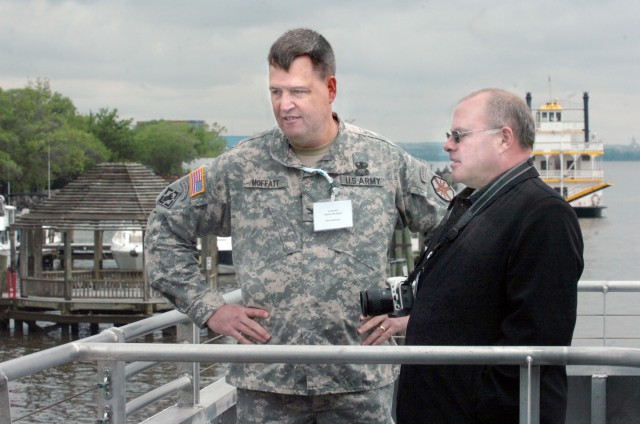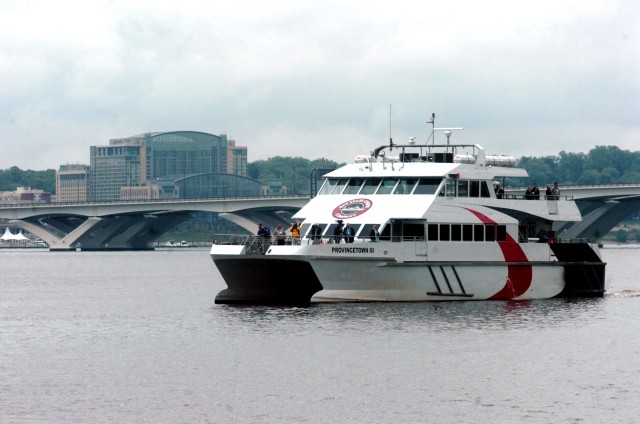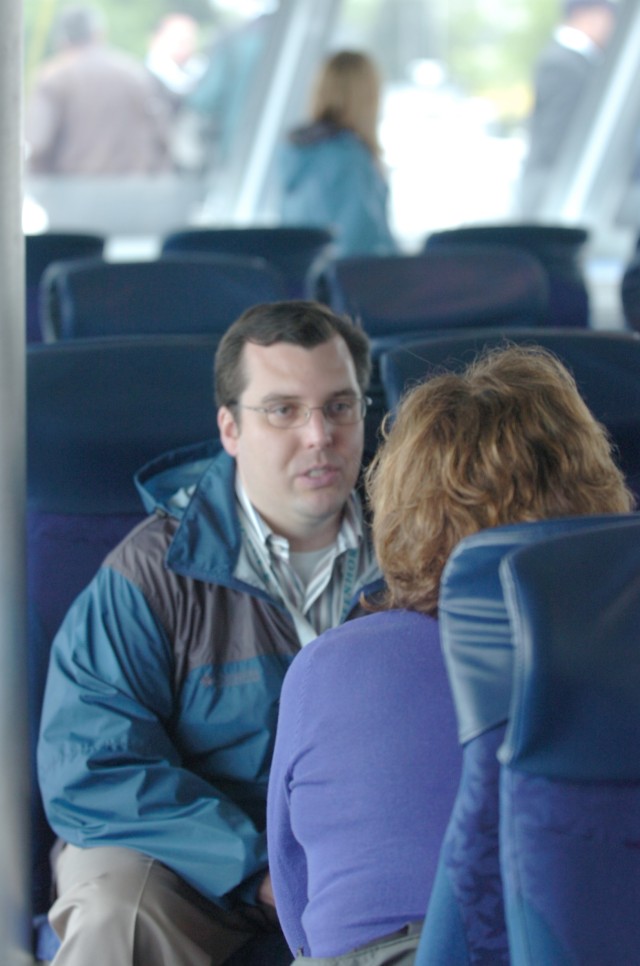Prince William County conducts feasibility study for ferry service
FORT BElVOIR, Va. -- Fort Belvoir Public Affairs Officials from Fort Belvoir cruised the Potomac River Tuesday and Wednesday, and, although several said the ride was pleasing, it was not a pleasure cruise.
The Belvoir contingent boarded the 149- seat, cataA,AA,Amaran ferry to take part in several test runs conducted by Prince William County which received $ 225,000 from the Virginia Department of Transportation to study the feasibility of the service.
The county's Department of Transportation conducted the test runs Monday through Wednesday with a route that took riders from Quantico to Dumfries, Occoquan, Belvoir, Alexandria and the Washington Navy Yard.
According to Cody Smith, a contractor helping to run the tests, there are three main goals of the trial runs: to gather hard run times to update data from VDOT tests in 2000; to gather wake measurements to determine how the boat affects the marinas and coast; and, to gather noise measurements from teams stationed along the coast.
Smith said the next step would be a market study.
Juanita Green, Belvoir's transportation demand coorA,AA,Adinator, said she was pleased with what the ride offers. ' I thought the ride itself was good,' she said of Tuesday's test ride. 'It was a very relaxing, less stressful way to commute. The stress of driving on 95 and Route 1 can play havoc with your morning.' Green said although she lives less than 25 miles away in Woodbridge, her commute takes 35 to 45 minutes.
'With traffic, sometimes it takes me an hour to an hour and a half to get to work,' she said. 'I have tried altering my route, leaving at different times, staying later ... it all depends upon the day, weather, volume of traffic and conditions.' She said the future of the ferry service depends on the ability of the service to meet demands of the potential users.
'I think it is something I and others would possibly use. It depends on the cost and the convenience,' she said.
Col. Mark Moffatt, Belvoir's deputy installation commander for transformaA,Ation and Base Realignment and Closure, also took the ride Tuesday. He said he thought the overall program - the testing Monday, Tuesday and Wednesday A,Awas beneficial.
'I'm glad I went. It proved it can work. It is a nice way to travel,' Moffatt said.
However, he cited the ecoA,Anomics of using the ferry and travel time as being potential drawbacks.
'The proof is in the pudA,Ading as to whether it's ecoA,Anomical,' he said. 'Unless it can be made an economical operation between the ferry boat companies and the fedA,Aeral [mass transit] stipend, people aren't going to use it. 'Another issue is timing,' he said. 'It took almost 30 minutes to get out of the Occoquan to get out to the main channel.
'A lot of people were conA,Acerned it was going to be more expensive than it was worth,' he said. Moffatt said one of the benefits of the trial was it showed the potential for ferry service to Belvoir on a smaller scale.
'We need to push the ferry boat [ companies] to figure out how to do a short run with a smaller craft - just Maryland to Belvoir.
'Ten percent of our work force lives in Maryland. That part is very viable,' he said.
Claude McMullen, Belvoir's director of logistics, who was also aboard for the ride Tuesday, agreed.
'If it is found to be a reliA,Aable and affordable form of transportation, I think it'd most affect our employees who come in from Maryland,' he said.
'Coming right across the water to Belvoir makes it so they don't have to travel north, and then on the Woodrow Wilson Bridge and then south again, either on Route 95 or Route 1,' McMullen said. 'I also think it'd work well further south, such as originating someA,Awhere near Fredericksburg.' McMullen also said ferry service may benefit Belvoir residents who work at the Pentagon, depending on how close a dock can be to a Metro station.
'The whole ferry is a neat idea,' McMullen said. 'It's another alternative for transportation to and from Fort Belvoir. We have to look at everything that's availA,Aable to us. 'It could work. We'll see' he said.
Belvoir officials say one of the challenges of having ferry service is the same they face for other alternate forms of transportation - finding a way for commuters to get to their workplaces once they arrive at the gates of the post.
To that end, Belvoir's Transportation Planning Group continues to study ideas for providing an interA,Anal post shuttle that will pick up commuters at their point of arrival - a ferry dock if ferry service comes to Belvoir - and drop them off at their places of duty.
According to a FAQ sheet about the ferry study from the office of Supervisor Frank J. Principi of Woodbridge, a host of the event, a technical report regarding the study, scheduled to be completed in June, will address routes, iniA,Atial service level and landside infrastructure.
VDOT conducted a similar study in 2000. However, the local travel environment has changed since then, with deA,Amographic growth in the Route 1 and 1-95 corridor, acA,Acording to the sheet.
Officials expected the new study to address real run times and operational conA,Acerns like river traffic, debris, weather and night operaA,Ations.
After the completion of the technical report, a study team is expected to make a public presentation to the Prince William County Public Board of County Supervisors. Public comment opportunities will then come later, if the project moves forward.








Social Sharing